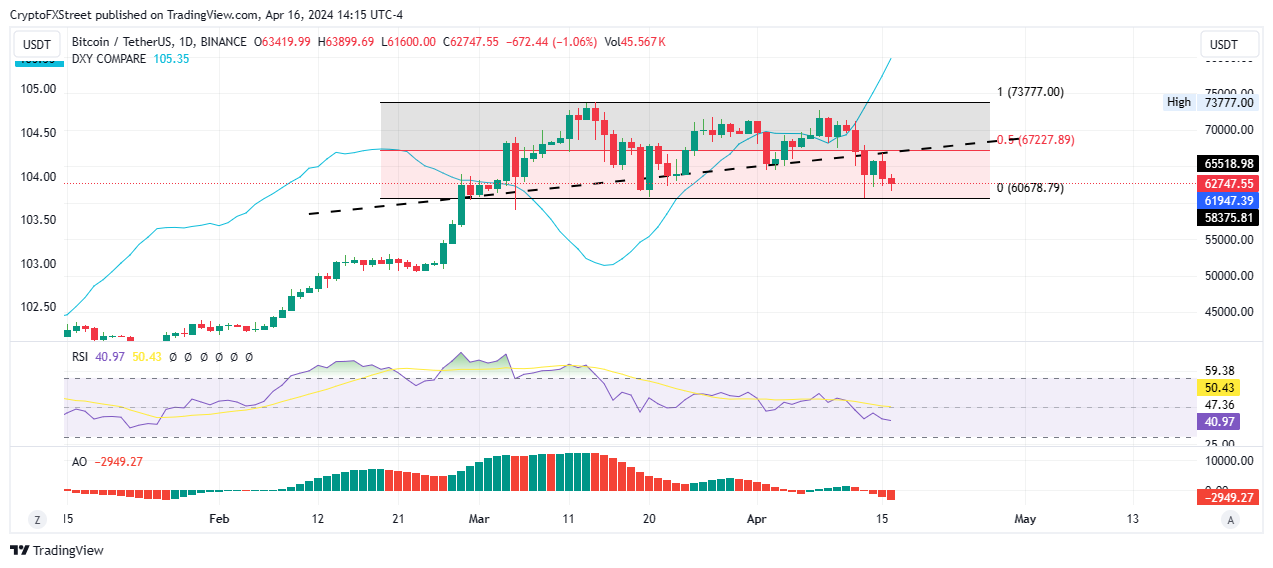- Bitcoin price continues to lean south following Fed Chair’s comments on Tuesday.
- Jerome Powell said recent data “shows lack of further progress on inflation.”
- Inflation has introduced new uncertainty on whether the Fed can cut rates later this year.
Bitcoin (BTC) price continues to stall with markets leaning south. The outlook was not influenced by statements from the Federal Reserve (Fed) on Tuesday, April 16 speech.
Also Read: US Dollar extends gains following Powell’s words
Summary of Fed Chair Powell’s comments
Fed Chair Jerome Powell gave his report on inflation and interest rates, with all signs pointing to the hope for a pivot getting overwhelmed alongside the agency’s fight against inflation.
The Fed’s hope for a pivot appears to be getting overwhelmed, with the sentiment extending to its fight against inflation. It comes on the back of inflationary deficit spending expanding the money supply for years. According to comments by the Fed Chair, these deficits are projected to continue at similar levels at least for the foreseeable future.
POWELL SAID FIRM INFLATION LAST QUARTER HAS INTRODUCED NEW UNCERTAINTY OVER WHEN AND WHETHER THE FED WILL BE ABLE TO LOWER RATES LATER THIS YEAR
— *Walter Bloomberg (@DeItaone) April 16, 2024
The highlights of the report include:
- There has been a lack of further progress on inflation based on recent data.
- There is new uncertainty concerning whether the Fed can cut rates later this year because of inflation data from the last quarter.
- Fed can maintain higher rates for “as long as needed,” said Powell, adding that recent data has not given greater confidence on inflation.
- Powell also observed that restrictive Fed policy needs more time to work, articulating that it will likely take longer to “regain confidence” on inflation returning to 2%.
The reversal is surprising, considering the Fed was talking about how many rate cuts are coming this year less than three months ago. Now, it is a question of whether rate cuts even come at all.
Fed FAQs
Monetary policy in the US is shaped by the Federal Reserve (Fed). The Fed has two mandates: to achieve price stability and foster full employment. Its primary tool to achieve these goals is by adjusting interest rates. When prices are rising too quickly and inflation is above the Fed’s 2% target, it raises interest rates, increasing borrowing costs throughout the economy. This results in a stronger US Dollar (USD) as it makes the US a more attractive place for international investors to park their money. When inflation falls below 2% or the Unemployment Rate is too high, the Fed may lower interest rates to encourage borrowing, which weighs on the Greenback.
The Federal Reserve (Fed) holds eight policy meetings a year, where the Federal Open Market Committee (FOMC) assesses economic conditions and makes monetary policy decisions. The FOMC is attended by twelve Fed officials – the seven members of the Board of Governors, the president of the Federal Reserve Bank of New York, and four of the remaining eleven regional Reserve Bank presidents, who serve one-year terms on a rotating basis.
In extreme situations, the Federal Reserve may resort to a policy named Quantitative Easing (QE). QE is the process by which the Fed substantially increases the flow of credit in a stuck financial system. It is a non-standard policy measure used during crises or when inflation is extremely low. It was the Fed’s weapon of choice during the Great Financial Crisis in 2008. It involves the Fed printing more Dollars and using them to buy high grade bonds from financial institutions. QE usually weakens the US Dollar.
Quantitative tightening (QT) is the reverse process of QE, whereby the Federal Reserve stops buying bonds from financial institutions and does not reinvest the principal from the bonds it holds maturing, to purchase new bonds. It is usually positive for the value of the US Dollar.
At the time of writing, Bitcoin price is trading for $62,747, maintaining the price action that had been seen during the Asian session. Among the factors influencing investor sentiment include the oncoming BTC halving on April 20 and turmoil in the Middle East that has investors fleeing to safety offered by the more traditional assets.

BTC/USDT 1-day chart
Also Read: Bitcoin price tanks to $62K ascribed to geopolitical tension a week to BTC halving

























